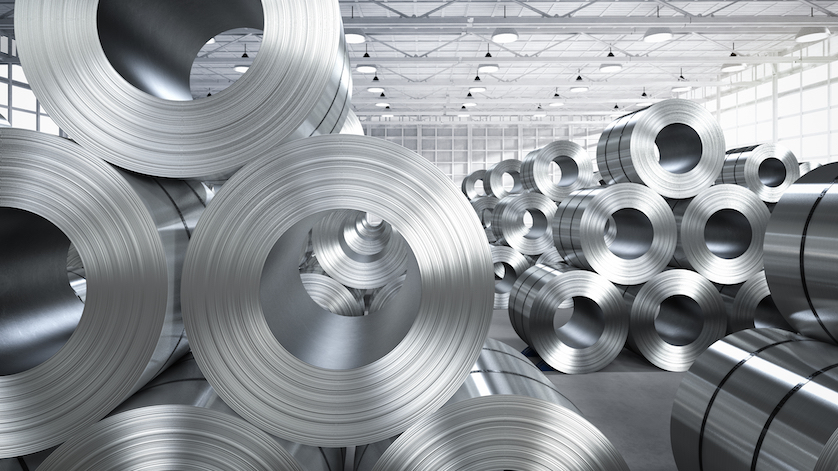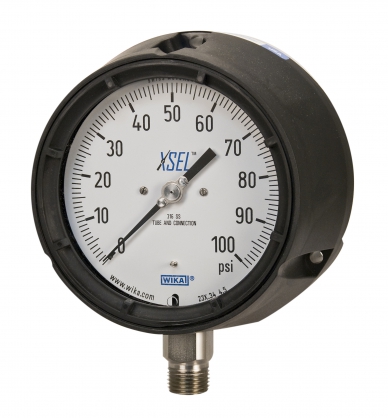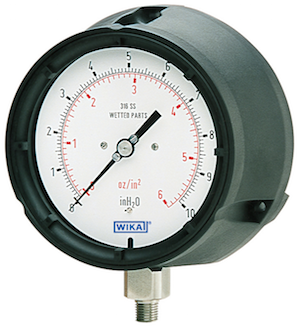
Companies in the biotechnology, chemical, food processing, petrochemical, oil refining and other industries rely on gauges to keep their operations running properly. For engineers and technicians at these and other facilities, stainless steel pressure gauges serve critical roles for ensuring the safety and efficiency of various processes.
How do you choose a pressure instrument? The choice depends on numerous factors, mainly accuracy, features, utility, and safety. But how about the material: copper alloy (brass) or stainless steel?
Brass is an economical and suitable option for many applications. However, for corrosion resistance, extreme temperatures, and overall system integrity, choose a stainless steel pressure gauge.
1. Protection against corrosion
Gauges with copper alloy (brass) wetted parts – socket, end piece, Bourdon tube, etc. – are excellent options for use around hydraulic oil, water, air, and other non-aggressive liquids and gases. However, only stainless steel resists the corrosion that can lead to system breaches and gauge failure. In general, use a stainless steel gauge around ammonia, creosote, aggressive solvents, or other harsh chemicals.
But even with non-corrosive media, it is critical to verify the media compatibility and makeup of the copper alloy. This is because some media can be completely harmless in certain states and stages, yet become aggressive in the presence of other substances, such as water or oxygen. For example, carbon dioxide is chemically stable and inert, but becomes carbonic acid (H2CO3) when dissolved in water.
2. Reliability in extreme temperatures
In very low ambient temperatures, such as found in the oil fields near the Arctic Circle, stainless steel pressure gauges are the better option. Why? To seal the socket and case together, most SS gauges have a welded connection rather than use an O-ring made of elastomer, which becomes brittle – and loses its sealing properties – at low temperatures. WIKA’s PG23LT stainless steel pressure gauge with silicone-oil case filling is especially designed for optimal performance in ambient temperatures down to −94°F (−70°C).
In applications with very hot media, such as steam, stainless steel pressure gauges are the only viable choice. This is because brass gauges are soldered, and soldering has a much lower melting point than stainless steel. Use brass gauges when the media is below 140°F (60°C). Compare those to WIKA’s XSEL® process gauges 232.34 and 233.34 with a welded stainless steel system, which has a short-term intermittent maximum temperature limit of 500°F (260°C).
Note: An additional error of ±0.4% of span will occur for every ±18°F (10°C) deviation from the reference temperature of 68°F (20°C). As an example, an XSEL® process gauge is exposed to a media temperature of 158˚F. This is a difference of 90˚F from the reference temperature. Let’s do the math:
90°F / 18°F = 5
5 x 0.4% = 2.0%
As the standard accuracy for an XSEL® is ±0.5%, the new total error for this pressure gauge becomes ±2.5% of full span when exposed to a media temperature of 158°F.
3. System integrity
WIKA’s “All Stainless Steel” gauges models 23X.30, 23X.50, 23X.53, and 23X.54 are laser welded between the socket and the case, which make them more durable in high-vibration applications. The typical O-ring seals in brass gauges are not very resistant to severe shocks and vibrations.
Dry or Liquid-filled Case for a Pressure Gauge
Most WIKA’s stainless steel pressure gauges come standard with either a dry liquid-fillable case or a liquid-filled case; both have an ingress protection of IP65. We recommend that customers opt for liquid-filled gauges whenever possible because case filling:
- Lubricates and cools all moving parts.
- Dampens the gauge internals.
- Protects internals from environmental influences.
- Helps with high-pressure cycles (pulsation) in combination with a restrictor.
- Eliminates pointer flutter.
- Prevents lens fogging and ice buildup.
In short, a liquid fill extends the service life of a gauge and improves its functionality.
WIKA USA’s Portfolio of Stainless Steel Gauges
WIKA’s pressure gauges with 316 stainless steel wetted parts and 304 stainless steel cases are designed specifically for heavy-duty services in harsh applications. Other models, like the 233.55 2.5-inch gauge and the 23X.30 4.5-inch gauge, come standard with a 316 SS case and ring. For corrosive environments or in offshore applications, most of our stainless steel gauges and thermometers, like the TG53 bimetal thermometer, offer the option of having the case, stem, and process connection be made of 316 SS as well.
Our stainless steel gauges have features that help minimize downtime. Many models come standard with a removable bezel ring, giving users access to the front of the gauge for zero-point adjustments or to replace a broken window. This design feature saves production time and keeps budgets on track.

XSEL® stainless steel process gauge
WIKA offers stainless steel models in all of our pressure gauge lines, from commercial and industrial to process and high precision. In the industrial and process line, stainless steel Bourdon tube gauges are the preferred instruments for petrochemical refineries, onshore and offshore locations, mechanical engineering, water/wastewater, and power plants. And as mentioned earlier, we definitely recommend the gauges to be liquid filled due to the extreme operating conditions found in these industries.
WIKA’s XSEL® process gauge, available with 316 stainless steel wetted parts, is ideal for sour gas (hydrogen sulfide) service in the petroleum industry, power stations, onshore and offshore mining, and chemical/petrochemical and environmental applications. This is because XSEL® stainless steel pressure gauges offer superior shock resistance and load-cycle stability, along with positive pressure ranges up to 20,000 psi. This gauge meets the requirements by NACE International standards MR-01-75 and MR-01-03. The XSEL® models with stainless steel components includes 232.34 and 233.34. For sour gas service, some customers prefer models 262.34 and 263.34 with Monel® wetted parts.

632.34 capsule (low pressure) process gauge with 316 SS wetted parts
For measuring very low pressures, including gas media as low as 10″ H2O (inches water column), WIKA offers a low-pressure stainless steel capsule pressure gauge model 632.34 and 63X.50. Our all stainless steel Sealgauges™ (diaphragm pressure gauges) are go-to instruments in sanitary piping systems, pulp and paper, and the wastewater industry. The products in this line include models 43X.30, 43X.50, 43X.36, and 43X.56. In addition, WIKA’s 332.54 and 332.34 test gauges with stainless steel construction are perfect for high-precision testing, laboratory use, and calibration.
Regardless of the application, industrial and process-grade gauges with stainless steel components offer reliability, high precision, and long service life in the harshest conditions. For more information about whether a copper alloy or stainless steel pressure gauge is right for your specific application, contact WIKA USA.
- PG23LT stainless steel Bourdon tube pressure gauge for extremely low ambient temperatures
- 232.34 (dry), 233.34 (liquid filled) XSEL® stainless steel process gauge
- All Stainless Steel pressure gauges 23X.30, 23X.50, 23X.53, and 23X.54
- 233.55 2.5″ gauge and the 23X.30 4.5″ gauge with a 316 SS case and ring
- TG53 bimetal thermometer with optional 316 SS case, stem, and process connection
- 262.34 and 263.34 XSEL® process gauge with Monel® wetted parts
- 632.34 and 63X.50 low-pressure stainless steel capsule gauge
- 43X.30, 43X.50, 43X.36, and 43X.56 Sealgauges™ (diaphragm pressure gauges)
- 332.54 and 332.34 stainless steel test gauges


are excellent options for use around hydraulic oil, water, air, and other non-aggressive liquids and gases
Hi wika.us owner, Your posts are always well written and informative.